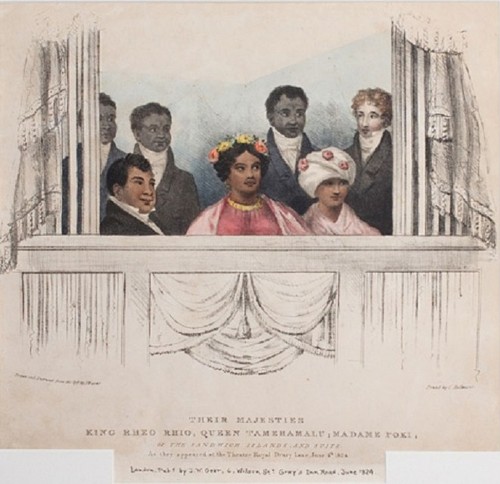In 1823 Liholiho, Kamehameha II, the 2nd King of unified Hawaii, chartered a boat and set off for England, along with his wife, Queen Kamamalu, and a party of other Hawaiian nobles.
Can you imagine how daring and adventurous this was?
Liholiho was born in the 18th century, when Hawaii was just beginning to have contact with the West. His exact birth date is not even recorded, and he barely spoke English. Sea travel was still a long, arduous, and dangerous endeavor. And yet Liholiho was determined to go; to see and understand the world that was beginning to to have such an effect on his kingdom.
He and his entourage set off in the L’Aigle, stopping in Brazil to meet Emperor Pedro I, and arriving in London in May 1824. Liholiho and Kamamalu were welcomed by the Foreign Secretary, had balls and receptions thrown in their honour, and toured all of London’s top sites.
Everywhere they went they caused a stir; travel was still so difficult that foreign royalty were still a huge novelty, and Hawaii was especially remote and exotic. Queen Kamamalu in particular created a sensation, she was over 6 foot tall, strikingly beautiful, and with an innate sense of style. The turban she wore to the theatre was particularly remarked upon and became the latest style among the ladies of the ton.

Portrait of Queen Kamamalu from an etching, 1824-1830. Photograph by Antique Associates at West Townsend, Inc. www.aaawt.com
While the balls, receptions, plays and performances were thrilling, Liholiho was there for a purpose: to meet his fellow monarch, George IV. A reception was set for June 21st. Alas, the scheduled meeting never happened.
On June 20 Kamamalu became ill with measles. A few days later Liholiho was also sick. Kamamalu died on July 6th, and the grief-stricken Liholiho was so distraught that he refused to leave her body. Without his beloved wife he lost the will to live, and passed away 6 days later. Hawaii had lost both it’s King and Queen in a far, cold land.
Just as he had planned, but not at all in the way he wanted, Liholiho experienced one of the big effects the outside world would have on his island paradise: when measles made it to Hawaii a few years later it devastated the native population.



I have read a lot Hawaiian history, and knew this sad story, but I had never seen these pictures. Thank you so much for sharing.
Amazingly, there are quite a few paintings from this trip. The etching of Queen Kamamalu in particular inspired a number of artists who did paintings based on it, and the etching itself sold very well. It just shows how memorable she was!
The interesting thing is that they are still ‘finding’ paintings of Kamamalu and other members of the expedition. One showed up at an auction in England a decade or so ago described as a Caribbean painting of a wealthy mulatto woman, and someone from Hawaii just happened to see it during the auction preview and realised who and what it actually was, and managed to arrange for it to be purchased by a Hawaiian museum.
Oh dear, what a story! I know nothing about Hawaiian history. Could you sometimes share more? Please?
Absolutely. I will add it to my list of interesting bits of history. I just have to figure out how to present the stories in blog-able tidbits!
Hawaiian history is so interesting because it is not remote. We all ‘knew someone who knew someone’, and that makes it all the more real and tragic. If only that were the case on the eastern mainland. In the end, though, it is just…so sad.
Thank you for sharing the story, and the images. I’m new to Hawaii, having moved here from the mainland less than a year ago, and very much enjoying the depth and scope of Hawaiian history to be learned. The fashion, in particular, is fascinating me! It is so very remarkable to see the styles of 19th and early 20th century Europe on the tall, stately, richly-colored and nobly-featured Hawaiian royalty; they bring a unique Something to it — a richness, or vitality, perhaps. I am looking forward to hunting down more of those elegant images…and, if my sewing machine ever gets here from the mainland (grumble), my husband has promised to help me recreate those styles for us. There is something about the lovely tree-lined parkways in Kapiolani Park and graceful buildings downtown…they sit in a quieter, more graceful century, which modern development all around them somehow cannot touch…and there is a magic there just waiting. I can’t help but feel that all we need is the proper attire and deportment, and perhaps we will slide right out of this time, back to Then.